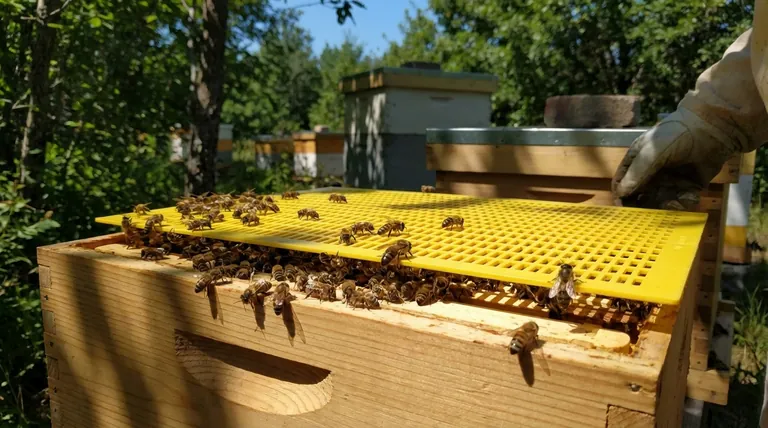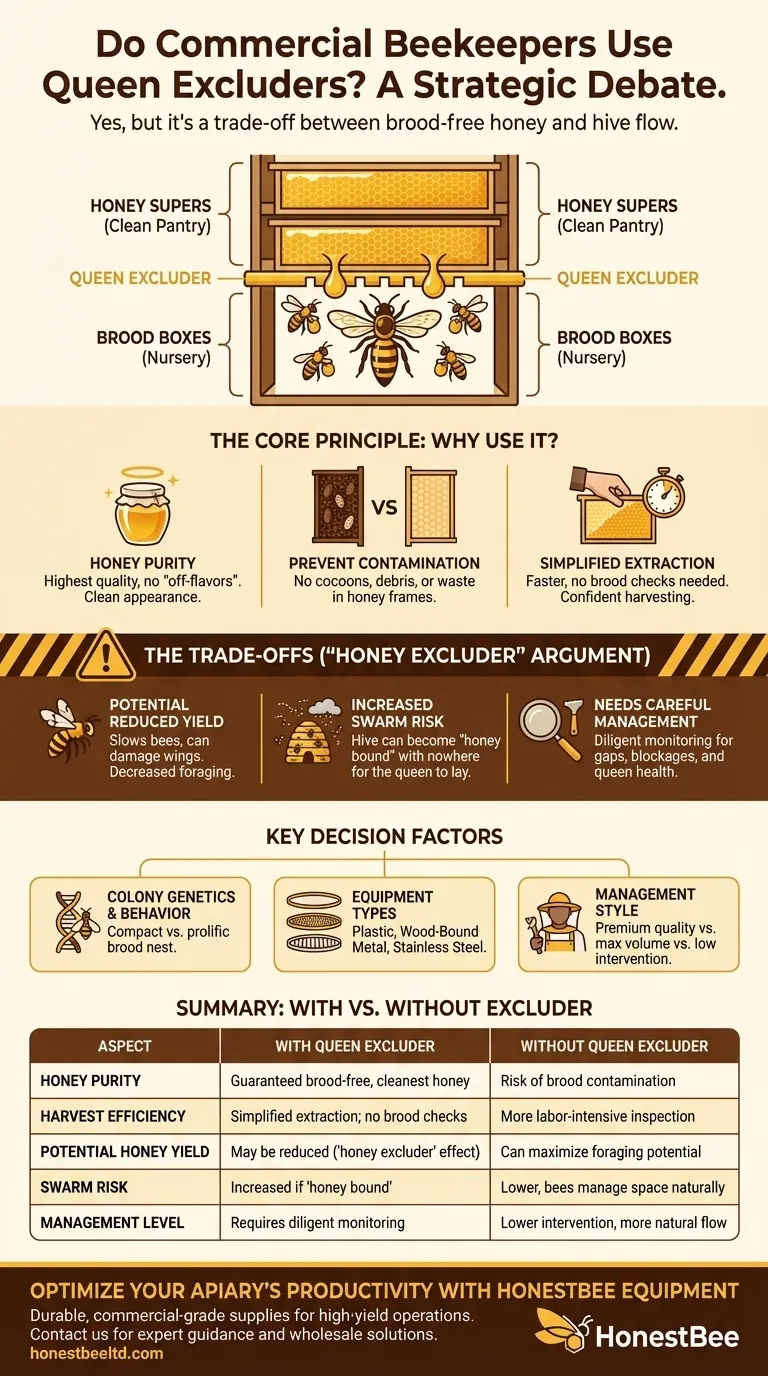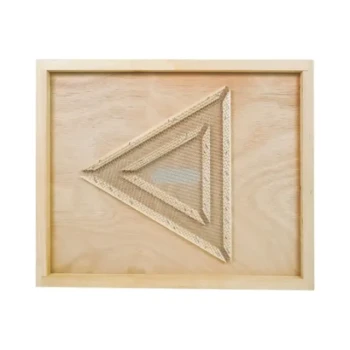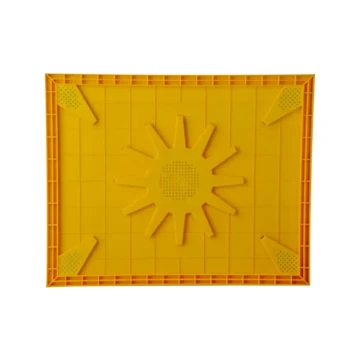Yes, many commercial beekeepers use queen excluders, but it remains one of the most debated practices in the field. The core function of an excluder is to confine the queen bee to the lower brood boxes, ensuring the upper honey supers remain exclusively for honey storage. This prevents the queen from laying eggs in the honey frames, leading to a cleaner and more straightforward harvest.
The decision to use a queen excluder is not about a single right or wrong answer; it's a strategic choice. It forces a trade-off between guaranteeing brood-free honey and potentially hindering the hive's natural workflow and productivity.

The Core Principle: Why Use a Queen Excluder?
The primary motivation for using a queen excluder is to create a clear separation between the "nursery" of the hive and the "pantry." This provides several distinct advantages for the beekeeper.
Ensuring Honey Purity
Honey harvested from frames that have never contained brood (eggs, larvae, and pupae) is often considered the highest quality.
It lacks the "off-flavors" that can sometimes be introduced from the brood-rearing process and has a cleaner, more appealing appearance.
Preventing Brood Contamination
When a queen lays in honey frames, the hatched larvae leave behind cocoons, debris, and waste.
This results in darker-colored combs and can introduce remnants into the final honey product if not carefully filtered. An excluder eliminates this problem at the source.
Simplifying Honey Extraction
With an excluder, beekeepers can pull frames from the honey supers with complete confidence that they are not removing or harming developing bees.
This makes the process of uncapping and extracting honey faster and more efficient, as there's no need to inspect each frame for brood.
Understanding the Trade-offs: The "Honey Excluder" Argument
Opponents of this tool often refer to it derisively as a "honey excluder." This nickname highlights the potential downsides, which are critical to understand before implementing one in your operation.
Potential for Reduced Honey Yield
The slots in an excluder are just large enough for worker bees to pass through. However, squeezing through this barrier can slow them down.
This constant transit can also damage the bees' wings over time, reducing their foraging lifespan and, consequently, the hive's overall honey production.
Increased Swarm Risk
A queen excluder can create a "barrier mentality" in the hive. Worker bees may become reluctant to cross it, choosing instead to store incoming nectar in the brood chamber.
This can quickly fill the brood nest with honey, leaving the queen with no room to lay. This condition, known as being "honey bound," is a major trigger for swarming.
The Need for Careful Management
Using an excluder is not a "set and forget" solution. It requires diligent monitoring.
Beekeepers must ensure the excluder is installed correctly without gaps, that it doesn't become blocked with pollen or propolis, and that the queen remains healthy and productive below it. Some beekeepers add an upper entrance above the excluder to reduce traffic through the barrier.
Key Factors in Your Decision
The choice to use an excluder depends less on universal rules and more on your specific context, including your bees, your goals, and your equipment.
Colony Genetics and Behavior
Different bee genetics exhibit different behaviors. Some colonies, particularly those with locally-bred queens, naturally keep a tight, compact brood nest and are eager to store honey above it.
Other, more prolific lines may be more inclined to expand the brood nest upwards relentlessly. These colonies are often the best candidates for an excluder.
Equipment Types
Not all excluders are created equal. They are typically available in three materials:
- Plastic: Inexpensive and lightweight, but can warp and generally last only a few years.
- Wood-Bound Metal: A rigid wooden frame holds a wire grid. These are durable but require careful handling to avoid damage.
- Stainless Steel: The most durable and long-lasting option, though also the most expensive.
Making the Right Choice for Your Operation
Your decision should be guided by your primary objective and management style.
- If your primary focus is premium honey quality: Use a queen excluder to guarantee brood-free combs, which is essential for producing the purest, highest-grade honey.
- If your primary focus is maximizing honey volume: Consider forgoing the excluder, especially if your bees tend to keep a tidy brood nest on their own. Be prepared for more intensive frame management during extraction.
- If your primary focus is low-intervention beekeeping: Avoid the excluder to allow the hive to manage its space more naturally, but accept the need to carefully monitor the queen's location.
Ultimately, treating the queen excluder as a specific tool for a specific job, rather than a default component, is the mark of an effective beekeeper.
Summary Table:
| Aspect | With Queen Excluder | Without Queen Excluder |
|---|---|---|
| Honey Purity | Guaranteed brood-free, cleanest honey | Risk of brood contamination in honey supers |
| Harvest Efficiency | Simplified extraction; no brood checks | More labor-intensive frame inspection |
| Potential Honey Yield | May be reduced ("honey excluder" effect) | Can maximize foraging and storage potential |
| Swarm Risk | Increased if hive becomes "honey bound" | Lower, as bees manage space naturally |
| Management Level | Requires diligent monitoring and setup | Lower intervention, more natural hive flow |
Optimize Your Apiary's Productivity with the Right Equipment
As a commercial beekeeper or distributor, your success hinges on efficient, high-yield operations. The decision to use a queen excluder is a perfect example of how the right tool impacts your bottom line.
HONESTBEE supplies durable, commercial-grade beekeeping supplies and equipment designed for the demands of large-scale apiaries and distributors. We help you navigate these critical choices by providing:
- High-Quality Excluders: Choose from durable stainless steel or wood-bound metal options built to last season after season.
- Expert Guidance: Get advice tailored to your specific operation, goals, and bee genetics.
- Wholesale-Focused Operations: Benefit from pricing and bulk options designed for commercial clients.
Let's discuss the best strategy for your hives. Contact our team of experts today to find the perfect equipment solution to maximize your honey quality and yield.
Visual Guide

Related Products
- Professional Plastic Queen Excluder for Modern Beekeeping
- Wooden Queen Bee Excluder for Beekeeping
- Premium Wood Framed Metal Wire Queen Bee Excluder
- Metal Queen Bee Excluder for Beekeeping
- High Performance Plastic Queen Excluder for Beekeeping and Apiary Management
People Also Ask
- What is the role of a queen excluder when adding a super? Ensure Brood-Free Honey Harvests
- What are the pros of using a queen excluder? Boost Hive Control & Honey Quality
- How do queen excluders work in terms of spacing and bee movement? A Guide to Precision Hive Management
- Why are queen excluders recommended for Flow Hives? Prevent Brood Damage for a Clean Harvest
- What is the purpose of a queen excluder when adding a super? Streamline Your Honey Harvest



















